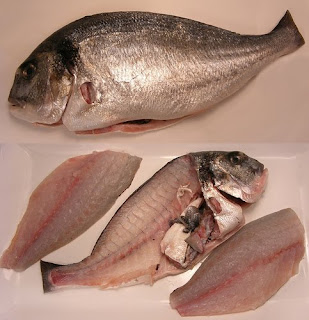Fish Stock
This recipe is a foundation for a great deal of advanced fish cookery, but making fish stock is pretty simple. Once it's finished, this stock freezes well for up to three months, and remains usable for up to six months.
The biggest difference between fish stock and other stocks is time: Fish stocks do not need hours and hours to come together the way beef or chicken stocks do.
Use lean fish like bass or cod - avoid oily fish like salmon or mackerel.
Prep Time: 20 minutes
Cook Time: 1 hour
Ingredients:
- 3 T. olive oil
- 3 lb. fish spines, fins and heads
- 1/2 of a large parsnip root, sliced into rounds
- 1 leek, sliced thin
- 2 stalks celery, sliced
- 1 carrot, sliced into rounds
- trimmings from a fennel bulb
- 1/2 cup sliced button mushrooms
- 1/2 bunch parsley
- A 1-inch piece of ginger, peeled and sliced thin
- 2 bay leaves
- 1 garlic clove, smashed
- 1 sprig of fresh thyme or 1 t. dried
- 1 cup dry white wine, such as a pinot grigio
- Cold water
- Salt
Preparation:
Wash bones and heads well under cold water. If the gills are still attached, cut them out. They impart a bitter flavor you do not want.
Heat a large pan for 2 minutes on high heat, then add the oil.
Turn the heat down to medium and add the fish bones. You do not want them to brown, only to get a little color. Cook, stirring frequently, for about 5 minutes. Remove and set aside.
In a tall stockpot, add the wine and reduce it by half under high heat. Once this is done, add the fish bones and turn off the heat for now.
In the pan you sweated the fish bones in, add the vegetables and cook until the leeks are translucent. Stir frequently. When they are cooked but not browned (a little browning is OK), add them to the stockpot.Add the herbs to the stockpot, stir everything to combine, and add enough cold water to cover it all by an inch.
Bring the stock up to a simmer. Do not let it boil. It is important that you don't let it boil, because fish stock will get cloudy in a hurry if you do. Look for a shimmer on the surface, not burble. If you have a thermometer you want something between 170-180 degrees.
Once the stock is at a simmer, move the pot off to one side of the burner a little. This will direct any impurities to one side, making it easier to skim. Simmer like this for 40 minutes.
After 40 minutes, strain the stock through a fine mesh strainer with a piece of cheescloth set inside. Clean the stockpot and then return the stock to the now-clean pot. Taste it. Now is the time to add salt. Add enough to suit your taste.
Pour into quart jars and freeze. Make sure you leave enough space at the top of the jars to account for the stock expanding when it freezes!


Comments